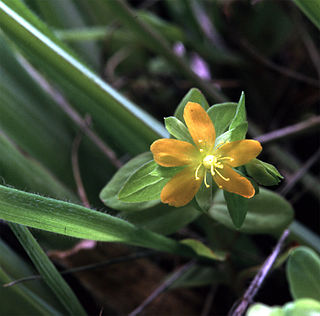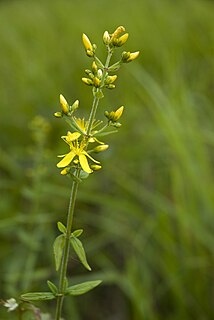
Hypericum is a genus of flowering plants in the family Hypericaceae. The genus has a nearly worldwide distribution, missing only from tropical lowlands, deserts and polar regions. Many Hypericum species are regarded as invasive species and noxious weeds. All members of the genus may be referred to as St. John's wort, and some are known as goatweed. The white or pink flowered marsh St. John's worts of North American and eastern Asia are now separated into the genus Triadenum.

Hypericaceae is a plant family in the order Malpighiales, comprising six to nine genera and up to 700 species, and commonly known as the St. John’s wort family. Members are found throughout the world apart from extremely cold or dry habitats. Hypericum and Triadenum occur in temperate regions but other genera are mostly tropical.

Hypericum anagalloides is a species of flowering plant in the St. John's wort family Hypericaceae. It is known by the common names creeping St. John's-wort, tinker's penny and bog St. John's-wort.

Hypericum canariense is a species of flowering plant in the family Hypericaceae known by the common name Canary Islands St. John's wort. It is the sole member of Hypericumsect. Webbia.

Hypericum maculatum, commonly known as imperforate St John's-wort, or spotted St. Johnswort, is a species of perennial herbaceous flowering plant in the family Hypericaceae. It is native to Europe and Western Asia where it grows in moist meadows.

Hypericum mutilum is a species of St. John's wort known by the common name dwarf St. John's wort. It is native to parts of North America and is present in other parts as an introduced species. It is an annual or perennial herb taking a multibranched erect form up to about 60 centimeters tall. The oval green leaves are one or two centimeters long and are covered in tiny glands. The inflorescence is a compound cyme of tiny flowers. H. mutilum subsp. mutilum and subsp. boreale have a diploid number of 16, and H. mutilum subsp. boreale can have a diploid number of 18.

Hypericum hirsutum is a species of flowering plant in the family Hypericaceae, commonly known as hairy St John's-wort. It is found in Western Europe.

Hypericum pulchrum is a flowering plant in the family Hypericaceae, commonly known as slender St John's-wort. It is native to Western Europe.

Hypericum boreale, also known as northern St. John's-wort, is a short-lived perennial species of flowering plant in the family Hypericaceae, section Trigynobrathys.
Hypericum cuisinii is a perennial herb in the genus Hypericum, in the section Adenosepalum. The herb has pale yellow flowers and occurs in Greece and Turkey.

Hypericum canadense, known as Canadian St. Johns-wort, lesser St. John's wort, and lesser Canadian St. Johnswort, is a flowering plant in the genus Hypericum. It is a yellow-flowering annual or perennial herb native to North America and introduced to Ireland and The Netherlands. The specific epithet canadense means "Canadian".

Hypericum japonicum, known as matted St. John's-wort, is an annual herbaceous flowering plant in the St. John's wort family Hypericaceae, in Hypericum sect. Trigynobrathys.

Hypericum majus, the greater Canadian St. John's wort, is a perennial herb native to North America. The specific epithet majus means "larger". The plant has a diploid number of 16.
Hypericum sampsonii is a species of flowering plant in the St. John's wort family, Hypericaceae. It occurs in China, Taiwan, Japan, Myanmar, and Vietnam. It is one of two species of Hypericum in the section Hypericum sect. Sampsonia.

Hypericum lancasteri, known as Lancaster's St. John's wort or as zhan e jin si tao in Chinese, is a species of flowering plant in the St. John's wort family Hypericaceae. The species has been awarded the Royal Horticultural Society's Award of Garden Merit.

Hypericum patulum, known as goldencup St. John's wort or yellow mosqueta, is a species of flowering plant in Hypericumsect. Ascyreia.

Hypericum formosissimum is a species of flowering plant in the family Hypericaceae, section Adenosepalum, in the Hypericum huber-morathii group.

Hypericum aucheri, also known as Koramanotu in Turkish, is a herbaceous perennial flowering plant in the St. John's wort family Hypericaceae.
Hypericum harperi, the sharplobe St. Johnswort or Harper's St. John's wort, is a perennial flowering plant in the family Hypericaceae. It is an aquatic herb native to southeast North America. H. harperi has a diploid chromosome number of 24.

















